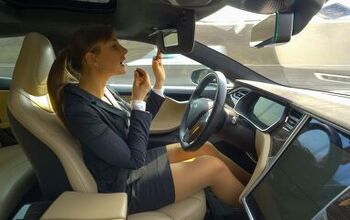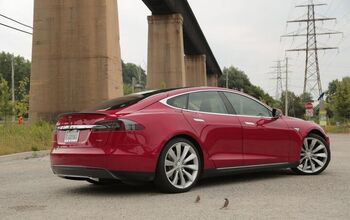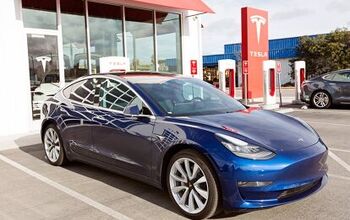NHTSA Probes Latest Autopilot-related Tesla Crash

Last Friday’s crash of a Model S in South Jordan, Utah will get the magnifying glass treatment from the National Highway Traffic Safety Administration. The agency announced Wednesday it will send a team of investigators to probe why the vehicle — which the admittedly distracted driver said was in Autopilot mode at the time of impact — collided with a stopped fire truck at 60 mph.
It’s the second NHTSA investigation of an Autopilot-related collision this year.
According to local police, witnesses claim the Model S did not attempt to brake as it approached the back of the fire truck, stopped at a traffic light. The 28-year-old driver reportedly suffered a broken foot in the crash.
At the time of the daylight collision, light rain was falling and the roadway was wet.
“NHTSA will take appropriate action based on its review,” the agency said Wednesday. While the NHTSA can order a recall if it uncovers a safety defect in the course of its probe, Tesla’s semi-autonomous driving system — which carries a warning for drivers to stay alert and keep their hands on the wheel — complicates the matter. Does a danger posed by misuse of a potentially fallible feature warrant a recall? We’ll have to wait and see.
At the very least, the public should know why the vehicle’s radar and camera combo didn’t recognize the approaching truck, or, if they did, why the vehicle didn’t take evasive action.
The NHTSA hasn’t yet released a preliminary report for the other recent incident — a March collision in Mountain View, California that claimed the life of an Apple employee. In the aftermath of that crash, Tesla and the National Transportation Safety Board found themselves at loggerheads. The feds later turfed Tesla from the investigation for publishing details of the crash.
A recent non-Autopilot-related crash of a Tesla Model S in Florida, which led to the deaths of two teens, is also the focus of an NHTSA probe.
Ever since the Mountain View crash, Musk and Tesla have doubled down on Autopilot safety claims, but the statistic used to illustrate the system’s life-saving abilities is attracting a growing list of detractors.
[Source: Automotive News] [Image: Tesla]

More by Steph Willems
Latest Car Reviews
Read moreLatest Product Reviews
Read moreRecent Comments
- Kjhkjlhkjhkljh kljhjkhjklhkjh I own my house 100% paid for at age 52. the answer is still NO.-28k (realistically) would take 8 years to offset my gas truck even with its constant repair bills (thanks chevy)-Still takes too long to charge UNTIL solidsate batteries are a thing and 80% in 15 minutes becomes a reality (for ME anyways, i get others are willing to wait)For the rest of the market, especially people in dense cityscape, apartments dens rentals it just isnt feasible yet IMO.
- ToolGuy I do like the fuel economy of a 6-cylinder engine. 😉
- Carson D I'd go with the RAV4. It will last forever, and someone will pay you for it if you ever lose your survival instincts.
- THX1136 A less expensive EV would make it more attractive. For the record, I've never purchased a brand new vehicle as I have never been able to afford anything but used. I think the same would apply to an EV. I also tend to keep a vehicle way longer than most folks do - 10+ years. If there was a more affordable one right now then other things come to bear. There are currently no chargers in my immediate area (town of 16K). I don't know if I can afford to install the necessary electrical service to put one in my car port right now either. Other than all that, I would want to buy what I like from a cosmetic standpoint. That would be a Charger EV which, right now, doesn't exist and I couldn't afford anyway. I would not buy an EV just to be buying an EV. Nothing against them either. Most of my constraints are purely financial being 71 with a disabled wife and on a fixed income.
- ToolGuy Two more thoughts, ok three:a) Will this affordable EV have expressive C/D pillars, detailing on the rocker panels and many many things happening around the headlamps? Asking for a friend.b) Will this affordable EV have interior soft touch plastics and materials lifted directly from a European luxury sedan? Because if it does not, the automotive journalists are going to mention it and that will definitely spoil my purchase decision.c) Whatever the nominal range is, I need it to be 2 miles more, otherwise no deal. (+2 rule is iterative)


































Comments
Join the conversation
This just in: Tesla technicians recovered data from the vehicle and found that the driver repeatedly cancelled and then re-engaged features of Autopilot. The vehicle registered more than a dozen instances of her hands being off the steering wheel in this drive cycle, according data retrieved by Tesla technicians. On two such occasions, she had her hands off the wheel for more than one minute each time and her hands came back on only after a visual alert. Are you Fing kidding me! Time to recall these car and disable this feature. This Bimbo put so many lives in danger, and Musk every time he open his piehole only emboldens his kool aid drinkers.
This could be about 99.99% of Tesla drivers. When on autopilot, vast majority do not touch the wheel. Besides, I really doubt Tesla can detect fingers touching the wheel. They can only detect WEIGHT on the wheel. I know because I deal with this every day driving my Tesla. Well then I guess you are a very lucky guy that it wasn't you wife and kids in that cross walk instead of that HUGE fire truck.